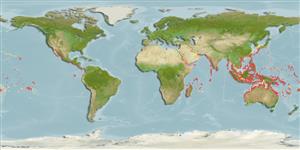Common names from other countries
Classification / Names / Names
Namen | Synonyme | Catalog of Fishes (gen., sp.) | ITIS | CoL | WoRMS
Environment: milieu / climate zone / depth range / distribution range
Ökologie
; brackwasser; tiefenbereich 0 - 30 m (Ref. 348). Tropical
Indo-Pacific: from East Africa, to eastern Polynesia; north to southern Japan and south to central Queensland.
Length at first maturity / Size / Gewicht / Alter
Maturity: Lm ? range ? - ? cm Max length : 8.5 cm SHL Männchen/unbestimmt; (Ref. 348); common length : 5.0 cm SHL Männchen/unbestimmt; (Ref. 348)
Life cycle and mating behavior
Geschlechtsreife | Fortpflanzung | Ablaichen | Eier | Fecundity | Larven
Members of the class Bivalvia are mostly gonochoric, some are protandric hermaphrodites. Life cycle: Embryos develop into free-swimming trocophore larvae, succeeded by the bivalve veliger, resembling a miniature clam.
Poutiers, J.M. 1998. (Ref. 348)
IUCN Rote Liste Status (Ref. 130435: Version 2024-1)
CITES Status (Ref. 108899)
Not Evaluated
Not Evaluated
Bedrohung für Menschen
Harmless
Nutzung durch Menschen
Fischereien: kommerziell
| FishSource |
Tools
Mehr Information
Alter/GrößeWachstumLänge-GewichtLänge-LängeMorphologieLarvenDichte
Internet Quellen
Estimates based on models
Preferred temperature
(Ref.
115969): 24.5 - 29.3, mean 28.4 (based on 3437 cells).
Verwundbarkeit
Low vulnerability (10 of 100).
Preiskategorie
Unknown.
